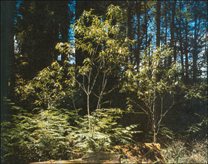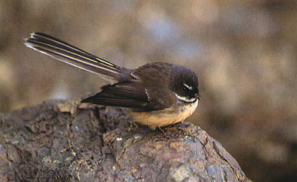Acknowledgements
The Project directors acknowledge the vital support and contributions of many people to this report, including:
• the very dedicated staff of the Educational Assessment Research Unit
• Dr Lynne Whitney, Ms Jacky Burgon and Dr David Philips of the Ministry of Education
• members of the Project's National Advisory Committee
• principals, staff, and children of the schools where tasks were trialled
• principals, staff, and Board of Trustee members of the 286 schools included in the 1999 sample
• the 3223 children in the 1999 sample, and their parents
• the 106 teachers who administered the assessments to the children
• the 49 senior tertiary students who assisted with the marking process
• the 155 teachers who assisted with the marking of tasks early in 1999
 |
Growing
in the Mighty Forest |
New
Zealand's National Education Monitoring Project commenced
in 1993, with the task of assessing and reporting on the achievement
of New Zealand primary school children in all areas of the school
curriculum. Students are assessed at two class levels: Year 4 (halfway
through primary education) and year 8 (at the end of primary education).
Different curriculum areas and skills are assessed each year, over
a four year cycle. The main goal of national monitoring is to provide
detailed information about what children can do so that patterns
of performance can be recognised, successes celebrated, and desirable
changes to educational practices and resources identified and implemented.
Each year, small random samples
of students are selected nationally, then assessed in their own schools
by teachers specially seconded and trained for this work. Task instructions
are given orally by teachers, through video presentations, on laptop
computers, or in writing. Many of the assessment tasks involve the students
in the use of equipment and supplies. Their responses are presented orally,
by demonstration, in writing, in computer files, or through submission
of other physical products. Many of the responses are recorded on videotape
for subsequent analysis. The use of many tasks with both year 4 and year
8 students allows comparisons of the performance of year 4 and 8 students
in 1999. Because some tasks have now been used twice, in 1995 and again
in 1999, trends in performance across the four year period can also be
analysed.
In 1999, the first year of the second cycle of national monitoring, three
areas were assessed: science, art, and the use of graphs, tables and maps.
This report presents details and results of the assessments in science.
The aims of a science education include the development of knowledge and
understanding, skills of scientific investigation, and attitudes on which
such investigation depends. A framework for science education and its assessment
is presented in Chapter 2.
This framework highlights the four main content strands of the science
curriculum (the living world, physical world, material world, and planet
earth and beyond), and also indicates important scientific processes and
attitudes. Most students responded with considerable enthusiasm to tasks
involving hands-on experimentation, as individuals or as teams. They did
not perform very well in planning experimental work, but often corrected
the deficiencies of their planning while carrying out their investigations.
Recognition of the value of replication (repeating experimental steps,
observations and measurements) has increased a little since 1995, but there
is still considerable room for improvement.
 |
Birds |
Chapter 3 examines achievement relating to the living world curriculum strand. Averaged across 87 task components used with both year 4 and year 8 students, 13 percent more year 8 than year 4 students produced correct responses. This indicates that, on average, students have made useful progress between year 4 and year 8 in the skills assessed by the tasks. Not surprisingly, students at both levels were less successful in providing explanations for living world phenomena than in demonstrating their knowledge of the phenomena or their ability and classify and identify observable features of living world objects. Two trend tasks involving a total of 5 components were administered to year 4 students in both the 1995 and 1999 assessments. Averaged across these 5 components, 1 percent more students succeeded in 1999 than in 1995. This difference is not important. Three trend tasks involving 6 task components were administered to year 8 students in both the 1995 and 1999 assessments. Averaged across the 6 components, 1 percent more students succeeded in 1999 than 1995. Again, this difference is not important.
Chapter 4 examines achievement relating to the physical world curriculum strand. Averaged across 82 task components used with both year 4 and year 8 students, 12 percent more year 8 than year 4 students produced correct responses. This indicates that, on average, students have made useful progress between year 4 and year 8 in the skills assessed by the tasks. Tasks involving experimentation and observation of phenomena were usually performed very well, but students were often less successful with tasks which required knowledge or explanation. Six trend tasks involving a total of 45 components were administered to year 4 students in both the 1995 and 1999 assessments. Averaged across the 45 components, 1 percent more students succeeded in 1999 than in 1995. This difference is not important. Five trend tasks involving 39 task components were administered to year 8 students in both the 1995 and 1999 assessments. Averaged across the 6 components, 1 percent fewer students succeeded in 1999 than 1995. Again, this difference is not important.
 |
Candles |
Chapter 5 reports achievement relating to the material world curriculum strand. Averaged across 38 task components used with both year 4 and year 8 students, 15 percent more year 8 than year 4 students produced correct responses. This indicates that, on average, students have made substantial progress between year 4 and year 8 in the skills assessed by the tasks. Students at both levels were more successful in carrying out experimental procedures and reporting the results than in demonstrating their knowledge or giving explanations of material world phenomena. Four trend tasks involving a total of 23 components were administered to year 4 students in both the 1995 and 1999 assessments. Averaged across the 23 components, 2 percent more students succeeded in 1999 than in 1995. This difference is not large enough to be regarded as important. Five trend tasks involving 26 task components were administered to year 8 students in both the 1995 and 1999 assessments. Averaged across the 26 components, 2 percent more students succeeded in 1999 than 1995. Again, this difference is not important.
Chapter 6 examines achievement relating to the planet earth and beyond curriculum strand. Averaged across 34 task components used with both year 4 and year 8 students, 9 percent more year 8 than year 4 students produced correct responses. This indicates that, on average, students have made modest progress between year 4 and year 8 in the skills assessed by the tasks. Hidden within this picture of modest progress, however, were generally small differences on task components requiring careful observation and description but much larger differences on task components requiring explanation of mechanisms or issues. Although the assessments included two trend tasks, one of these focused mainly on attitudes to pollution and the other included just three small task components. Accordingly, it is inappropriate to summarise trends in performance for this curriculum stand.
Chapter
7 presents the results of the science surveys, which sought
information from students about their curriculum preferences and
their perceptions of their achievement and potential in science.
Students were also asked about their involvement in science related activities
within school and beyond. Students were asked to indicate their first three
preferences from a list of six class science activities. Two activities
("going on field trips" and "doing things like experiments")
were strong first preferences at both year levels, with year 4 slightly
favouring field trips and year 8 strongly favouring experiments.
Year 4 students were generally very positive about doing science at school
and would like to do more. Almost half wanted to keep learning about science
when they grew up, and about a quarter thought they would make good scientists
when they grew up. They were less confident that they learned a lot of
science at school, with about one third saying that they learned "heaps" and
only 16 percent saying that their class did really good things in science "heaps".
The proportions liking to do science things in their own time or saying
that they did really good science things in their own time were quite disappointing:
less than half used the descriptors "heaps" or "quite a
lot", and 19 percent said "never". There were indications
that much science in school is bookwork, with practical work and field
trips less common. Trends from 1995 to 1999 were variable, with both gains
and losses.
Compared to year 4 students, year 8 students were less inclined to use
the most positive categories. This pattern has been common in national
monitoring surveys. It is a concern that less than 30 percent of the year
8 students indicated that their class did really good things in science "heaps" or "quite
a lot".
Chapter
8 reports the results of analyses that compared the task
performance and survey responses of different demographic subgroups.
School type (full primary or intermediate), school size, community
size and geographic zone did not seem to be important factors predicting
achievement on the science tasks. The other five factors revealed
more substantial differences. Boys performed better than girls on
about 30 percent of the tasks at both year levels. Non-Mäori
students performed better than Mäori students on just 12 percent
of the tasks at year 4 level, but on 44 percent of the tasks at year
8 level (Mäori students scored higher on one year 8 task). Students
attending schools with high proportions of Mäori students scored
lower than students attending other schools about 40 percent of the
tasks at both year levels. Students attending schools with more than
10 percent Pacific Island students scored lower than students at
other schools on about 50 percent of the tasks at both year levels.
Most notably, there were statistically significant differences in
the performance of students from low, medium and high decile schools
on 54 percent of the year 4 tasks and 63 percent of the year 8 tasks.
Comparisons with the 1995 assessments are interesting. Most notably, the
percentage of tasks on which Mäori students performed worse than non-Mäori
students has declined dramatically for year 4 students (from 61 percent
of tasks to 12 percent), and slightly for year 8 students (from 58 percent
of tasks to 44 percent). While year 8 girls performed worse than boys on
about 30 percent of tasks in both 1995 and 1999, the gap has increased
for year 4 students (10 percent of tasks in 1995, 28 percent in 1999).
Chapter 9 reports the results of analyses of the achievement of Pacific Island students. Until this year, there have been too few Pacific Island students in the National Monitoring samples to allow their results to be separately analysed and reported. Starting this year, additional sampling of schools with high proportions of Pacific Island students permits comparison of the achievement of Pacific Island, Mäori and other children attending such schools. For year 4 students, there were statistically significant differences in performance among the three groups on 23 of the 50 tasks. The Pacific Island students scored significantly lower than the Mäori students on 7 tasks and than the "other" students on 20 tasks. The Mäori students scored significantly lower than the "other" students on 4 tasks. For year 8 students, there were statistically significant differences in performance among the three groups on 19 of the 48 tasks. The Pacific Island students did not score significantly lower than the Mäori students on any task, but were lower than the "other" students on 18 tasks. The Mäori students scored significantly lower than the "other" students on 9 tasks.